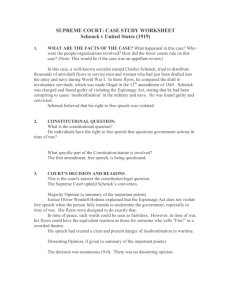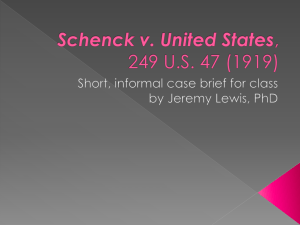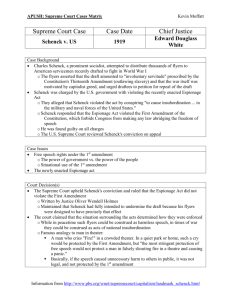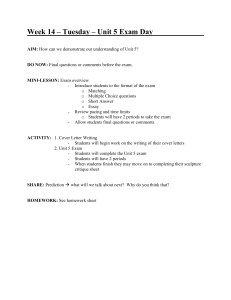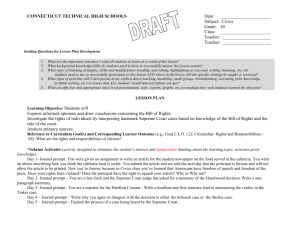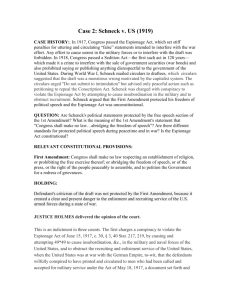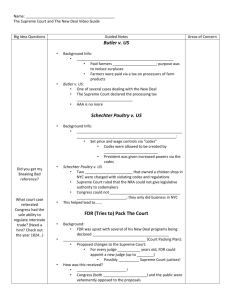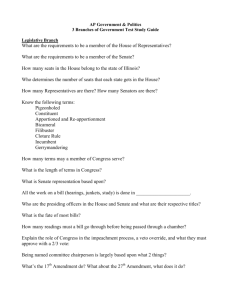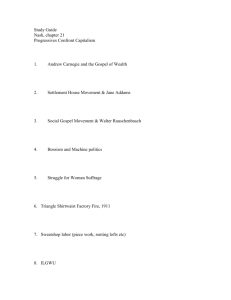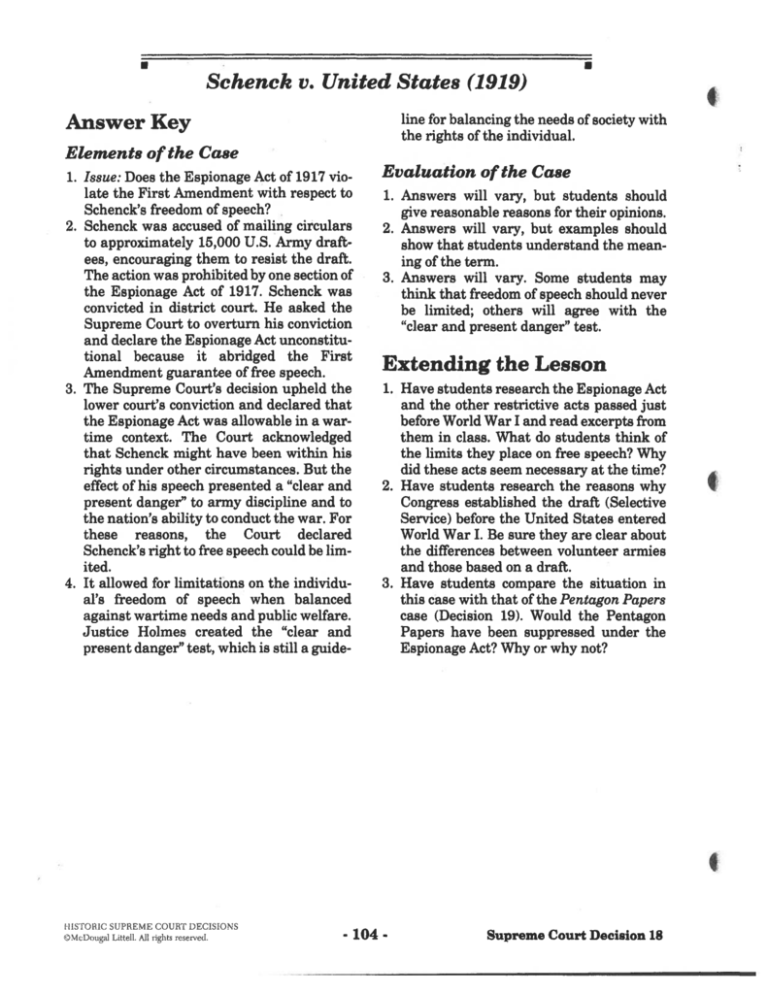
I
Schenck v. United States (1919)
I
line for balancing the needs of society with
the rights of the individual.
Answer Key
Elements of the Case
Evaluation of the Case
1. Issue: Does the Espionage Act of 1917 vio
late the First Amendment with respect to
Schenck’s freedom of speech?
2. Schenck was accused of mailing circulars
to approximately 15,000 U.S. Army draft
ees, encouraging them to resist the draft.
The action was prohibited by one section of
the Espionage Act of 1917. Schenck was
convicted in district court. He asked the
Supreme Court to overturn his conviction
and declare the Espionage Act unconstitu
tional because it abridged the First
Amendment guarantee of free speech.
3. The Supreme Court’s decision upheld the
lower court’s conviction and declared that
the Espionage Act was allowable in a war
time context. The Court acknowledged
that Schenck might have been within his
rights under other circumstances. But the
effect of his speech presented a “clear and
present danger” to army discipline and to
the nation’s ability to conduct the war. For
these reasons, the Court declared
Schenck’s right to free speech could be lim
ited.
4. It allowed for limitations on the individu
al’s freedom of speech when balanced
against wartime needs and public welfare.
Justice Holmes created the “clear and
present danger” test, which is still a guide-
1. Answers will vary, but students should
give reasonable reasons for their opinions.
2. Answers will vary, but examples should
show that students understand the mean
ing of the term.
3. Answers will vary. Some students may
think that freedom of speech should never
be limited; others will agree with the
“clear and present danger” test.
Extending the Lesson
1. Have students research the Espionage Act
and the other restrictive acts passed just
before World War I and read excerpts from
them in class. What do students think of
the limits they place on free speech? Why
did these acts seem necessary at the time?
2. Have students research the reasons why
Congress established the draft (Selective
Service) before the United States entered
World War I. Be sure they are clear about
the differences between volunteer armies
and those based on a draft.
3. Have students compare the situation in
this case with that of the Pentagon Papers
case (Decision 19). Would the Pentagon
Papers have been suppressed under the
Espionage Act? Why or why not?
I
e
HISTORIC SUPREME COURT DECISIONS
(PMcDougal Littell. All rights reserved.
-
104
-
Supreme Court Decision 18
I
Schenek v. United States (1919)
Vocabulary
abridging Lessening, interfering with.
neutral Not allied with or supporting ei
ther side in a war or dispute.
draft To select people for required military
service.
insubordination Unwillingness to accept
orders from someone in authority.
affirm To agree or support, as when a high
er court agrees with the earlier decision of
a lower court.
Reviewing the Case
The First Amendment guarantee of free
speech and expression reads: “Congress shall
abridging the freedom of
make no law.
speech. . . .“ But, at several different periods
in the history of the United States, Congress
has passed laws limiting how much citizens
can criticize or resist government actions. Is
this an abridgment of free speech? In the case
of Schenck v. United States, the Supreme
Court established a guideline that is still fol
lowed.
In 1917 the United States was still official
ly neutral, but its entry into World War I
was imminent. To build up the army, Con
gress passed an act on May 18, 1917, that es
tablished a military draft. To encourage
national unity in the war effort, Congress
also passed several laws that limited criti
cism of the government and opposition to its
policies. On June 15, 1917, Congress passed
the Espionage Act. Sections of the Espionage
Act prohibited any attempt to cause insub
ordination among military personnel or to
interfere with the draft or with military re
cruitment.
Three days later Charles Schenck was ar
rested for violating the Espionage Act. He
was accused of printing and mailing antiwar
pamphlets to some 15,000 to 16,000 men who
had been accepted for induction into the mili
tary under the Selective Service Act. Schenck
was the general secretary of the American
Socialist Party and, like most other members
of the party, he strongly opposed the war. He
.
‘
.
HISTORIC SUPREME COURT DECISIONS
©McDougai Littell. All rights reserved.
-
claimed it was being fought for the benefit of
Wall Street investors who would profit from
the sale of merchandise to the military.
The U.S. District Court for Pennsylvania
ruled that the pamphlets were designed to
cause men to resist the draft. Therefore, the
court decided, Schenck had violated the Es
pionage Act. Schenck claimed there was not
enough evidence to convict him of the charges
that had been brought against him. He said
that his actions were a form of free speech
and claimed that the Espionage Act abridged
the rights of free speech. Thus, according to
him, the act was unconstitutional. Convicted
in the district court, Schenck appealed to the
U.S. Supreme Court.
The issue before the Court: Does the Espio
nage Act violate the First Amendment in re
spect to Schenck’s freedom of speech?
The Supreme Court ruled unanimously to
affirm the decision of the district court
against Schenck. Writing for the Court, Jus
tice Oliver Wendell Holmes laid down a stan
dard that would become famous:
We admit that in many places and in ordi
nary times the defendants in saying all
that was said in the circular would have
been within their constitutional rights. But
the character of every act depends on the
circumstances in which it is done. The
most stringent protection of free speech
would not protect a man in falsely shouting
fire in a theatre, and causing a panic.
The question in every case is whether the
words used are used in such circumstances
and are of such a nature as to create a clear
and present danger that they will bring
about the substantive [actual] evils that
Congress has a right to prevent.”
In the Schenck decision, the Supreme
Court established clear limitations on free
dom of speech. The guideline is the existence
of a “clear and present danger,” a situation in
which free speech could bring harm to the
general welfare. In such cases, Congress has
the power to pass laws to protect its citizens
105
-
Supreme Court Decision 18
and the national security of the United States
even if those laws abridge free speech. The
“clear and present danger” test is a way to
balance the rights of the individual with
those of society.
According to Justice Holmes, it made no
difference that Schenck and the others had
failed to interfere with military recruitment.
“...We perceive no ground for saying that
success alone warrants making the act a
crime,” he concluded.
4
I
a
[i
t
I
ii
4
I.
HISTORIC SUPREME COURT DECISIONS
©McDougal Littell. All rights reserved.
106
-
Supreme Court Decision 18
,
Name
Date
Schenck v. United States (1919)
Elements of the Case
Directions: Fill in the appropriate information for each of the follow
Ing elements of the case.
1, State the issue before the Court.
2. What facts of the case were presented to the Court?
What was the decision of the Court? What was the rationale behind it?
What was the effect of the decision?
I S’IflH1C SUPREME COURT DECISIONS
(McI)ouga1 Littell. All rights reserved.
-
107
-
Supreme Court Decision 18
Schench v. United States (cont.)
Name
4
Evaluation of the Case
Directions: Use your own judgment to evaluate the justices’ decision
and state your opinion of that decision.
1. Do you agree that the free speech guarantees in the First Amend
ment should have limitations? Explain why you think as you do.
2. What does the term “clear and present danger” mean to you? Give at
least two examples of such situations.
4
3. Does this ruling, in your opinion, strike a proper balance between the
rights of the individual and the needs of society? Explain.
I
FITSTORIC SUPREME COURT DECISIONS
©McDougal Littell. All rights reserved.
-
108
-
Supreme Court Decision 18

